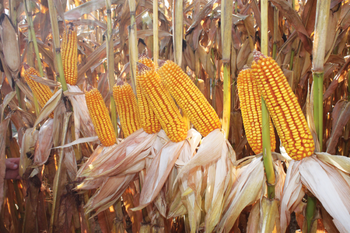
Deadlines nearing for decisions on farm bill programs
“Growers have until Feb. 27 to update yield history and/or reallocate base acres,” says Keith Coble. “You have until March 31 to make a one-time choice between ARC (Agricultural Risk Coverage) and PLC (Price Loss Coverage) for crop years 2014 through 2018. From mid-April through summer 2015, you can sign contracts for 2014 and 2015 crop years.” Coble served as chief economist for the minority staff of the Senate Agriculture, Nutrition and Forestry Committee during the 2013/14 farm bill debate.

Deadlines are nearing for decisions farmers need to make to comply with provisions of the new farm legislation, Keith Coble reminded peanut producers at the annual meeting of the Mississippi Peanut Growers Association.

KEITH COBLE
“You have until Feb. 27 to update yield history and/or reallocate base acres,” he said. “You have until March 31 to make a one-time choice between ARC (Agricultural Risk Coverage) and PLC (Price Loss Coverage) for crop years 2014 through 2018. From mid-April through summer 2015, you can sign contracts for 2014 and 2015 crop years.”
Coble, who is Giles Distinguished Professor of Agricultural Economics at Mississippi State University, served as chief economist for the minority staff of the Senate Agriculture, Nutrition and Forestry Committee during the 2013/14 farm bill debate.
He notes that help is available to producers from MSU’s Agricultural Economics Department in the form of spreadsheets that can be used in making the calculations (http://bit.ly/1tW5dLl). “You can plug in your own circumstances and figure out how it will work for you.”
Coble says also that the Mississippi Farm Service Agency has been “very cooperative in providing knowledgeable people to go to meetings and bring farmers up to speed on these provisions.” And he and other Mississippi Extension specialists have been on the meetings trail for the past few months.
Stay current on what’s happening in Mid-South agriculture: Subscribe to Delta Farm Press Daily.
Among the things farmers need to keep in mind about the new legislation, he says:
• “You can’t build base. If you have 200 acres of base on a farm serial number for a particular set of crops, when you get done you’re still going to have 200 acres of base. You can’t build it, but you can reallocate it.
• “Yield updating is probably one of the big no-brainers. Because of past programs and the inability to update base yields, we have a lot of farmers who have relatively low base yields. You now have the opportunity to take 90 percent of the 2008-2012 average, and in a lot of instances that will be a higher number. I would suggest you take a look at that.”
• PLC program: “The peanut industry and rice industry wanted a traditional price-triggered program however a price-triggered program was created for all program commodities. The corn reference price is $3.70, and the Congressional Budget Office said that would cost almost nothing — now look where corn prices are.”
In terms of ARC versus PLC, Coble says, “for rice and peanut farmers most analyses suggest PLC. I’d think really hard before I chose ARC on either of these crops. But for beans, corn, and wheat, it depends on what you think the price path is.
Decisions on ARC/PLC
Beans still look pretty favorable toward ARC; for corn, it’s more of a toss-up with an slight edge to ARC in most cases. In Mississippi, we have some counties that have a pretty good history with ARC, and others that don’t, so look at your own county.”
Farmers also need to keep in mind, he says, that “you can be in the PLC program and SCO (Supplemental Coverage Option), but if you’re in the ARC program you can’t purchase SCO insurance.
“The two versions of the ARC program are a shallow loss revenue program. The county-triggered program is commodity specific and pays on 85 percent of base acres. The area-triggered program is paid on 65 percent of base acres, and it is going to lump your farm serial numbers together and it’s going to be across all your commodities.”

"We were at pretty high commodity price levels when this bill was written; now we’re at lower price levels for several crops."
While the farm level ARC program was designed for wheat farmers in Montana, Coble says, “I could envision a few cases in Mississippi where someone has one farm serial number and is only growing one crop. This is a scenario where individual ARC might work.”
It’s also important to understand, he says, that with ARC, “rather than a fixed legislative target, it uses an olympic average on yield and price. Take the last five years, drop the high and the low, and average the other three.
We were at pretty high commodity price levels when this bill was written; now we’re at lower price levels for several crops. What we’re going to see is that ARC will likely ride these price levels down. We’ve got a lot of upward-trending yields, so it’s going to move in the opposite direction.”
SCO is very similar to ARC, he notes. “It’s a shallow loss insurance product, delivered by RMA (Risk Management Agency), with a premium subsidy of 65 percent of the total. The top coverage level is 86 percent, the same as ARC. For these products, RMA is moving toward using their own data rather than NASS county data for these yield series. It will be interesting to see how it works.
“You may purchase either STAX (Stacked Income Protection Plan) or SCO on cotton. STAX is just for cotton and is very similar to SCO, but has a higher premium subsidy — an 80 percent subsidy and a 90 percent guarantee. I think a lot of cotton producers will prefer STAX to SCO.”
Crop insurance coverage levels in Mississippi “have been going up fairly rapidly,” Coble says. “I thought we were catching up with the Midwest, but I was wrong. They’ve been moving to higher coverage (75 percent to 85 percent) and the primary reason for it is enterprise units — growers have gone to enterprise units in order to get higher coverage.
Switching for more benefit
The higher percentage the subsidy, the more benefit you get. That’s why I think we’ve got a lot of people switching from basic units to enterprise units. However, with enterprise units, you’re going to have some offsetting losses. If you’ve got a low yield field with a yield loss, and another field that doesn’t, they’ll be averaged together.

"There is a lot of bad information out there. Be very careful about using information from the Midwest to make decisions about crops here in the South."
With SCO, Coble says, “You’re topping off an individual coverage policy with an area trigger policy. In the past, you were never able to buy two insurance policies on the same acre — now you can. They’re intended to cover layers of loss. You can have two policies insuring the same acre.
“The ARC program, an FSA-delivered program, is doing much the same thing as SCO, but it’s not tied to the crop insurance choice you make. So, you can buy a coverage level that doesn’t match up to ARC, or you can buy a coverage level that laps over into the ARC range.”
As decision times near, Coble says, “I would suggest you ask your crop insurance agent five questions:
1. Can you give me a quote for enterprise units and trend adjusted yields?
2. Will you show me the premium for different coverage levels?
3. What about topping off individual coverage with SCO?
4. Will you give me a quote for separate coverage levels by practice?
5. What about the APH (Actual Production History) yield exclusion?”
And he cautions, “There is a lot of bad information out there. Be very careful about using information from the Midwest to make decisions here in the South.
Questions growers “need to be asking” about the ARC/PLC issue, Coble says:
1. How much do you want to protect yourself from risk or increase government payments? “Are you trying to protect yourself from risk, or are you trying to get the most money from the government?”
2. How much do you value having a price floor under the price of a crop? “If you sleep better at night when you’ve got a $3.70 floor under your corn, then take the PLC program, even though ARC might pay you more money. We don’t know what these programs are going to pay you in 2018. It’s just a guess.”
3. How much are you willing to depend on individual crop insurance for risk protection?
4. How much are you willing to depend on area-triggered crop insurance for risk protection? “Remember that area-triggered programs may not trigger when your farm has a loss. It’s not about whether your average yield is higher or lower — it’s about whether the county yield is low when your yield is low.”
5. How much are you going to worry about relatively small commodity program payments versus controlling cost?
Some “easy calls” for producers, Coble says, will be conversion of cotton base to generic base and yield updates. He notes that farm level ARC “may not be a good fit” for diversified producers, and says STAX will likely be preferred over SCO for cotton unless crop insurance coverage is low.
Among important things to remember: “Area-triggered programs may not trigger when you have a loss. Title 1 programs are on base acres, not planted acres. And, compared to direct payments which are paid every year, ARC, PLC, and SCO are expected to pay less than 50 percent of the time.”
About the Author(s)
You May Also Like



